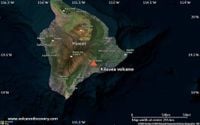Hawaii’s Kilauea volcano has once again captured the world’s attention with a series of dramatic eruptions in August 2025, underscoring its status as one of the planet’s most active and closely watched volcanoes. On August 22, Kilauea erupted for the 31st time since December 2024, sending a dazzling arc of lava soaring 100 feet into the air from its summit crater. Just two days later, on August 24, the volcano upped the ante, unleashing lava fountains that reached a staggering 325 feet, according to the US Geological Survey (USGS), as reported by NBC Palm Springs. These awe-inspiring displays have drawn crowds of visitors to Hawaii Volcanoes National Park and riveted virtual audiences worldwide, eager to witness nature’s fiery spectacle.
The latest eruptions have been nothing short of spectacular. Lava fountains from the north vent at the summit crater have spattered continuously, transforming the park into a vibrant gathering place for onlookers and scientists alike. Despite the intensity of the eruptions, officials have confirmed there was no immediate danger to nearby homes—although the risks associated with such volcanic events remain ever-present. The eruptions have been contained within the summit caldera, allowing visitors a rare front-row seat to one of Earth’s most powerful natural phenomena.
For many, the experience is unforgettable. Janice Wei, a local volunteer who documents the eruptions for both educational and personal purposes, described the sensory overload of being near the lava. “Every eruption feels like I am sitting in the front row at nature’s most extraordinary show,” she shared, capturing the excitement that draws so many to the park. She also noted the distinctive sounds—sometimes like a roaring jet engine, other times like crashing ocean waves—and the intense heat felt from over a mile away. Her enthusiasm is echoed by countless visitors who have flocked to the park or tuned in to USGS livestreams, eager for a glimpse of the fiery fountains.
Kilauea’s recent activity has provided scientists with a wealth of data and renewed questions about the volcano’s long-term behavior. The Hawaiian Volcano Observatory (HVO) has been closely monitoring the eruptions, which are fueled by a remarkable geological process. Ken Hon, the scientist-in-charge at HVO, explained that magma is accumulating beneath the Halemaumau Crater at a rate of about 5 cubic yards (3.8 cubic meters) per second. This steady influx creates immense pressure in the lower magma chamber, forcing magma upward through cracks and fissures, ultimately resulting in the dramatic lava fountains that have become Kilauea’s hallmark.
Hon offered an evocative analogy for the challenges scientists face in predicting volcanic activity: “Our job is like being a bunch of ants crawling on an elephant trying to figure out how the elephant works.” The complexity of Kilauea’s behavior, with its frequent eruptions and shifting patterns, makes forecasting future activity a daunting task. Scientists rely on a network of sensors to detect earthquakes and subtle changes in ground deformation, which can offer clues about impending eruptions days or even a week in advance.
The current sequence of eruptions is part of a broader pattern that has only occurred four times in the past 200 years, with previous episodes in 1959, 1969, and the prolonged eruption that began in 1983. During some episodes, lava fountains have soared over 1,000 feet (300 meters) into the air, though recent eruptions have produced shorter but wider fountains. Steve Lundblad, a geology professor at the University of Hawaii at Hilo, attributes this change to a widening vent, which reduces the pressure and results in broader, less towering displays. “We’re still gonna have spectacular eruptions,” he observed. “They’re just going to be wider and not as high.”
Kilauea’s frequent eruptions have also had a profound impact on tourism. According to data from Hawaii Volcanoes National Park, visitation soared by 49% in April 2025 compared to the same month the previous year—a testament to the volcano’s enduring allure. The park has become a magnet for both seasoned volcano watchers and first-time visitors, all eager to witness the power of nature up close. However, officials are quick to emphasize the potential dangers. Volcanic hazards such as unstable cliffs, toxic gases, ash, and razor-sharp glass fragments are ever-present risks. Jessica Ferracane, a spokesperson for the park, cautioned that some lava fountains have lasted only 10 to 12 hours, and urged visitors to sign up for USGS alerts and to stay on marked trails. “The eruption could be over before you know it,” she warned, highlighting the unpredictable and fleeting nature of these volcanic events.
Beyond the scientific and touristic fascination, Kilauea holds deep cultural significance for Native Hawaiians. The volcano is revered as the home of Pele, the goddess of fire, and its eruptions are seen as both a destructive and creative force. Huihui Kanahele-Mossman, executive director of the Edith Kanakaʻole Foundation, emphasized the importance of honoring Hawaiian traditions during these events. She described the practice of delivering chants and offerings—such as awa (a drink made with kava) and fern lei—at the crater, connecting the present-day eruptions to centuries-old stories and rituals. “You as the dancer, you are the storyteller and you carry that history that was written in those mele forward,” Kanahele-Mossman explained, underscoring the role of cultural practitioners in preserving and interpreting the meaning of Kilauea’s activity.
For many in the local community, the lava is not merely a destructive force but a vital resource that hardens into new land, forming the foundation of Hawaii Island itself. This ongoing cycle of destruction and renewal is woven into the spiritual and physical fabric of the islands, a testament to the enduring relationship between people and the volcanic landscape they call home.
Despite decades of study, many questions about Kilauea’s future remain unanswered. Will the current sequence of eruptions transition into a prolonged period of continuous lava flows, as happened after the 1983 eruption, or will the activity subside if the magma supply diminishes? Scientists continue to monitor the volcano closely, using every tool at their disposal to unlock the secrets of one of the world’s most dynamic natural wonders.
As the lava cools and new land forms, the story of Kilauea continues to unfold—an ever-changing narrative of geology, culture, and human curiosity that draws people from around the globe to witness its fiery displays. For now, both scientists and visitors remain captivated by the volcano’s unpredictable power and the promise of future eruptions that will shape Hawaii’s landscape for generations to come.


